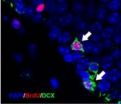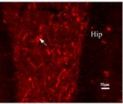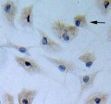(Press-News.org) CAMBRIDGE, Mass-- Last year, MIT researchers discovered that when water droplets spontaneously jump away from superhydrophobic surfaces during condensation, they can gain electric charge in the process. Now, the same team has demonstrated that this process can generate small amounts of electricity that might be used to power electronic devices.
The new findings, by postdoc Nenad Miljkovic, associate professor of mechanical engineering Evelyn Wang, and two others, are published in the journal Applied Physics Letters.
This approach could lead to devices to charge cellphones or other electronics using just the humidity in the air. As a side benefit, the system could also produce clean water.
The device itself could be simple, Miljkovic says, consisting of a series of interleaved flat metal plates. Although his initial tests involved copper plates, he says any conductive metal would do, including cheaper aluminum.
In initial testing, the amount of power produced was vanishingly small — just 15 picowatts, or trillionths of a watt, per square centimeter of metal plate. But Miljkovic says the process could easily be tuned to achieve at least 1 microwatt, or millionth of a watt, per square centimeter. Such output would be comparable to that of other systems that have been proposed for harvesting waste heat, vibrations, or other sources of ambient energy, and represents an amount that could be sufficient to provide useful power for electronic devices in some remote locations.
For example, Miljkovic has calculated that at 1 microwatt per square centimeter, a cube measuring about 50 centimeters on a side — about the size of a typical camping cooler — could be sufficient to fully charge a cellphone in about 12 hours. While that may seem slow, he says, people in remote areas may have few alternatives.
There are some constraints: Because the process relies on condensation, it requires a humid environment, as well as a source of temperatures colder than the surrounding air, such as a cave or river.
The system is based on Miljkovic and Wang's 2013 finding — in attempting to develop an improved heat-transfer surface to be used as a condenser in applications such as power plants — that droplets on a superhydrophobic surface convert surface energy to kinetic energy as they merge to form larger droplets. This sometimes causes the droplets to spontaneously jump away, enhancing heat transfer by 30 percent relative to other techniques. They later found that in that process, the jumping droplets gain a small electric charge — meaning that the jumping, and the accompanying transfer of heat, could be enhanced by a nearby metal plate whose opposite charge is attractive to the droplets.
Now the researchers have shown that the same process can be used to generate power, simply by giving the second plate a hydrophilic surface. As the droplets jump, they carry charge from one plate to the other; if the two plates are connected through an external circuit, that charge difference can be harnessed to provide power.
In a practical device, two arrays of metal plates, like fins on a radiator, would be interleaved, so that they are very close but not touching. The system would operate passively, with no moving parts.
For powering remote, automated environmental sensors, even a tiny amount of energy might be sufficient; any location where dew forms would be capable of producing power for a few hours in the morning, Miljkovic says. "Water will condense out from the atmosphere, it happens naturally," he says.
"The atmosphere is a huge source of power, and all you need is a temperature difference between the air and the device," he adds — allowing the device to produce condensation, just as water condenses from warm, humid air on the outside of a cold glass.
INFORMATION:The research, which also included MIT graduate student Daniel Preston and former postdoc Ryan Enright, now at Lucent Ireland Ltd., was supported by MIT's Solid-State Solar-Thermal Energy Conversion Center (S3TEC), funded by the U.S. Department of Energy; the Office of Naval Research; and the National Science Foundation.
Getting a charge out of water droplets
Water condensing and jumping from a superhydrophobic surface can be harnessed to produce electricity
2014-07-11
ELSE PRESS RELEASES FROM THIS DATE:
Virtual reality interface device and brain neural networks in neurological diseases
2014-07-11
Virtual reality interface devices permit the user to interact with the virtual world in real time through a variety of multisensory channels including hearing, sight, touch and smell. The virtual reality interface devices enable the reorganization of neural networks in the brain of patients with chronic stroke and cerebral palsy, thereby improving hand function and other skills, contributing to their quality of life. Virtual reality interface devices can also activate visual, vestibular and proprioceptive systems, which help control body posture and improve balance function. ...
Citalopram increases the differentiation efficacy of BMSCs into neuronal-like cells
2014-07-11
There is evidence that selective serotonin reuptake inhibitor antidepressants can promote neuronal cell proliferation and enhance neuroplasticity both in vitro and in vivo. Dr. Javad Verdi and his team, Tehran University of Medical Sciences, Iran proposed that citalopram, a selective serotonin reuptake inhibitor, can increase the efficacy of bone marrow mesenchymal stem cells (BMSCs) differentiating into neuronal-like cells. Experimental results confirmed that citalopram can improve the neuronal-like cell differentiation of BMSCs by increasing cell proliferation and survival ...
ADSCs transplantation promotes neurogenesis in Alzheimer's disease
2014-07-11
Recent evidence has demonstrated that transplantation of mesenchymal stem cells can stimulate neurogenesis in the brain of adult rat or mouse models of Alzheimer's disease (AD) and improve tissue and function injury under the condition of cerebral ischemia. Few studies are reported on the therapeutic effect of adipose-derived stem cells (ADSCs) transplantation in mice with AD and on the effect on oxidative injury and neurogenesis in the brain of AD mice. Dr. Yufang Yan and her team, School of Life Sciences, Tsinghua University, China transplanted ADSCs into the hippocampus ...
Substance P in hippocampus versus striatal marginal division for learning/memory function
2014-07-11
In addition to the hippocampus, the marginal division of the striatum is also involved in learning and memory. What is the impact degree of substance P in the striatal marginal division on learning and memory function? Yan Yu and his team, College of Biophotonics, South China Normal University, China found, using immunofluorescence staining, that substance P receptor, neurokinin 1 was highly expressed in the hippocampus and striatal marginal division of normal rats. Unilateral or bilateral injection of an antisense oligonucleotide against neurokinin 1 receptor mRNA in the ...
An obstacle to the differentiation of adipose-derived stromal cells into astrocytes
2014-07-11
There is evidence that under the normal circumstances, astrocytes participate in normal physiological activities and development, maintain neuronal environment, and exhibit therapeutic and repairing effects on brain injury and neurodegenerative disease. Previous studies have found that nerve cells differentiated from adipose-derived stromal cells after chemical induction have reduced viability, which produces influences on subsequent studies and application. Prof. Xiaodong Yuan, Kailuan General Hospital, Hebei United University, China demonstrated that after chemical induction, ...
Why anandamide can increase intracellular Ca2+ concentration?
2014-07-11
Evidence exists that cannabinoid receptor type 1 can inhibit voltage-gated calcium channel, decrease intracellular Ca2+ influx, and reduce neurotransmitter release. However, some scholars demonstrated that cannabinoid receptor type 1 can increase extracellular Ca2+ influx and increase neurotransmitter release. Dr. Yi Zhang and his team, Tongji Hospital Affiliated to Tongji Medical College, Huazhong University of Science and Technology, China used whole cell voltage-clamp and calcium imaging in cultured trigeminal ganglion neurons and found that anandamide directly caused ...
Exercise is the best medicine: QUT study
2014-07-11
Women would benefit from being prescribed exercise as medicine, according to a QUT study that revealed moderate to high intensity activity is essential to reducing the risk of death in older women.
Professor Debra Anderson, from QUT's Institute of Health and Biomedical Innovation, said that in addition to conventional treatments for physical and mental health, health professionals should be prescribing tailored exercise programs for older women.
Professor Anderson and QUT's Dr Charlotte Seib co-authored a paper published in the international journal of midlife health ...
'Expressive therapy" intervention assists women living with HIV
2014-07-11
New research from UC San Francisco shows that an "expressive therapy" group intervention conducted by The Medea Project helps women living with HIV disclose their health status and improves their social support, self-efficacy and the safety and quality of their relationships.
"Medication alone is totally insufficient," said the study's first author, Edward L. Machtinger, MD, director of the Women's HIV Program at UCSF. "Over 90 percent of our patients are on effective antiretroviral therapy but far too many are dying from suicide, addiction, and violence. Depression, addiction, ...
Growing up on a livestock farm halves the risk of inflammatory bowel diseases
2014-07-11
New research conducted at Aarhus University has revealed that people who have grown up on a farm with livestock are only half as likely as their urban counterparts to develop the most common inflammatory bowel diseases: ulcerative colitis and Crohn's disease. The study findings have recently been published in the European Journal of Epidemiology.
"It is extremely exciting that we can now see that not only allergic diseases, but also more classic inflammatory diseases appear to depend on the environment we are exposed to early in our lives," relates Vivi Schlünssen, Associate ...
BGI reports a novel gene for salt tolerance found in wild soybean
2014-07-11
Shenzhen, July 10, 2014---A team of researchers from The Chinese University of Hong Kong, BGI and other institutes have identified a gene of wild soybean linked to salt tolerance, with implication for improving this important crop to grow in saline soil. This study published online in Nature Communications provides an effective strategy to unveil novel genomic information for crop improvement.
Soybean is an important crop for the world. Due to domestication and human selection, cultivated soybeans have less genetic diversities than their wild counterparts. Among the lost ...
LAST 30 PRESS RELEASES:
Sleeping in on weekends may help boost teens’ mental health
Study: Teens use cellphones for an hour a day at school
After more than two years of war, Palestinian children are hungry, denied education and “like the living dead”
The untold story of life with Prader-Willi syndrome - according to the siblings who live it
How the parasite that ‘gave up sex’ found more hosts – and why its victory won’t last
When is it time to jump? The boiling frog problem of AI use in physics education
Twitter data reveals partisan divide in understanding why pollen season's getting worse
AI is quick but risky for updating old software
Revolutionizing biosecurity: new multi-omics framework to transform invasive species management
From ancient herb to modern medicine: new review unveils the multi-targeted healing potential of Borago officinalis
Building a global scientific community: Biological Diversity Journal announces dual recruitment of Editorial Board and Youth Editorial Board members
Microbes that break down antibiotics help protect ecosystems under drug pollution
Smart biochar that remembers pollutants offers a new way to clean water and recycle biomass
Rice genes matter more than domestication in shaping plant microbiomes
Ticking time bomb: Some farmers report as many as 70 tick encounters over a 6-month period
Turning garden and crop waste into plastics
Scientists discover ‘platypus galaxies’ in the early universe
Seeing thyroid cancer in a new light: when AI meets label-free imaging in the operating room
Neutrophil-to-lymphocyte ratio may aid risk stratification in depressive disorder
2026 Seismological Society of America Annual Meeting
AI-powered ECG analysis offers promising path for early detection of chronic obstructive pulmonary disease, says Mount Sinai researchers
GIMM uncovers flaws in lab-grown heart cells and paves the way for improved treatments
Cracking the evolutionary code of sleep
Medications could help the aging brain cope with surgery, memory impairment
Back pain linked to worse sleep years later in men over 65, according to study
CDC urges ‘shared decision-making’ on some childhood vaccines; many unclear about what that means
New research finds that an ‘equal treatment’ approach to economic opportunity advertising can backfire
Researchers create shape-shifting, self-navigating microparticles
Science army mobilizes to map US soil microbiome
Researchers develop new tools to turn grain crops into biosensors
[Press-News.org] Getting a charge out of water dropletsWater condensing and jumping from a superhydrophobic surface can be harnessed to produce electricity


